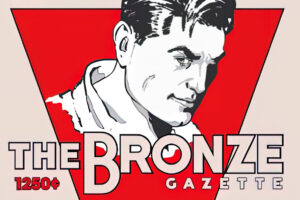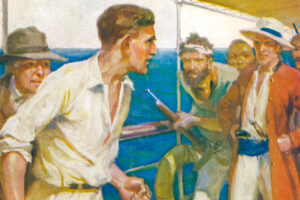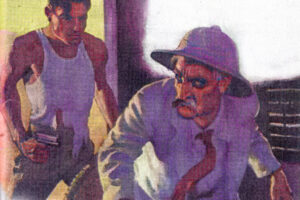Continuing my reading/re-reading of the Solar Pons stories, August Derleth‘s Sherlock Holmes pastiche, I now hit Vol. 6 of the Belanger Books set, which contains the only Solar Pons novels by Derleth: The Novels of Solar Pons: Terror Over London and Mr. Fairlie’s Final Journey.
 Written in the 1930s, Terror Over London was never published by Derleth, finally appearing in The Final Adventures of Solar Pons in 1998.
Written in the 1930s, Terror Over London was never published by Derleth, finally appearing in The Final Adventures of Solar Pons in 1998.
Mr. Fairlie’s Final Journey was published in 1968 by Derleth’s Mycroft & Moran imprint, between The Casebook of Solar Pons and The Chronicles of Solar Pons. But when Pinnacle Books reprinted it, they put it at the end as Volume 7 after Return (Pinnacle reorged the works for some reason), which is when I read it.
Also, Pinnacle had a very dull typeface for the Solar Pons book titles. With Mr. Fairlie, they came up with an interesting logo for Solar Pons that forshadowed the logo they’d roll out first with Dossier, the first of the Basil Copper collections, then use on the Derleth volumes when they were reprinted. I don’t think this happened with Mr. Fairlie as the logo they created was nice.
There is only one other Solar Pons novel, Satan’s Claw by Basil Copper. I find it interesting that while Derleth wrote more Solar Pons stories than Conan Doyle did for Holmes, Doyle wrote four Holmes novels and Derleth only did two, only one of which was published at the time. Some claim that Pons works better in shorter form. But we have many Holmes novels by several authors, so why can’t we have more Pons novels? I think for many, The Hound of the Baskervilles may be one of the most well-known of the Holmes stories. But the point can be made that these works are really short novels, novellas, rather than full novel-length works.
I also think it an interesting point that three of the four Holmes novels follow a similar structure. While Holmes and Watson investigate the crime, once they find the culprit we then have a long interlude where we learn the back story of why the crime occured, as it was tied to a larger, previous event. This is the case for A Study in Scarlet, The Sign of the Four, and The Valley of Fear. I don’t think I’ve noticed this used in too many Holmes novels written by others, but certainly if someone were to do something similar for a Pons novel, I think that would work.
As with the other Belanger volumes, we get two forwards, by David Marcum and Derrick Belanger. We also get the cover artwork from the Mycroft & Moran volume by Frank Utpatel, which has a map of Fromme, showing where Mr. Fairlie’s body was found.
Terror Over London is somewhat different from what you’d expect. But then it was written very early in the creation of Pons. It’s more of a fast action spy novel than a detective work. Dr. Parker is traveling by train from Madrid to Paris, after a trip, when the train is stopped and he’s pulled off. So has he run afoul of the Franco government? But no, he’s instead met by an agent of the government, and sent via plane to Pons with some mysterious papers.
It seems there is a criminal conspiracy, known only as “The Clubs,” that are menacing many of the governments in Europe and elsewhere (we hear of Tokyo and then the U.S. being involved). This organization is lead by a group known only by card names, headed by “The Deuce of Clubs.” It is thought this is really Dr. Heinrich von Storck, but he is clearly under some disguise. There is also a menacing hunchback, known as Dove and The Knave of Clubs. The Clubs are killing certain important people, stealing valuable government plans, and conducting bank robberies.
Aiding Pons is Lady Ysola Warrender, who is his first cousin. She never appears in any other work. I wonder if anyone will use her again, as we get so few female characters and Pons doesn’t have the equivalent to Irene Adler? Another interesting character is the American agent who helps out later on, John Devore. Maybe if we get a story of Pons in American, he can return. Bancroft Pons does not appear, but I suspect this was written well before Derleth had created him.
Overall it’s an interesting tale, if a little non-standard.
In Mr. Fairlie’s Final Journey, Pons is called in when the body of Jonas Fairlie is found near Fromme, with Pons’ address hidden in the lining of his hat. He had left Fromme, heading to London. Was he heading there to speak with Pons, and if so for what reason? And was this why he was killed, and if so, by whom? This is a complex mystery, as there are many characters to contend with such as various members of the Farwell family who employed Fairlie, and a story that takes Pons to several locations across England.
I wished that we’d had a map of Fromme — and England in general — to better understand the places Pons visited, and maybe a list of the various Farwell families and their members. The reprinted cover does help a bit for Fromme. And I wish Derleth had picked a name more different for some of the characters. A few times I was confused by “Fairlie” and “Farwell,” and found myself flipping back to make sure I had them straight. But this is a more complex mysteries than others, and a good read.
Next up will be Vol. 6 of Copper’s Solar Pons collections, which contains Satan’s Claw. How appropriate.



